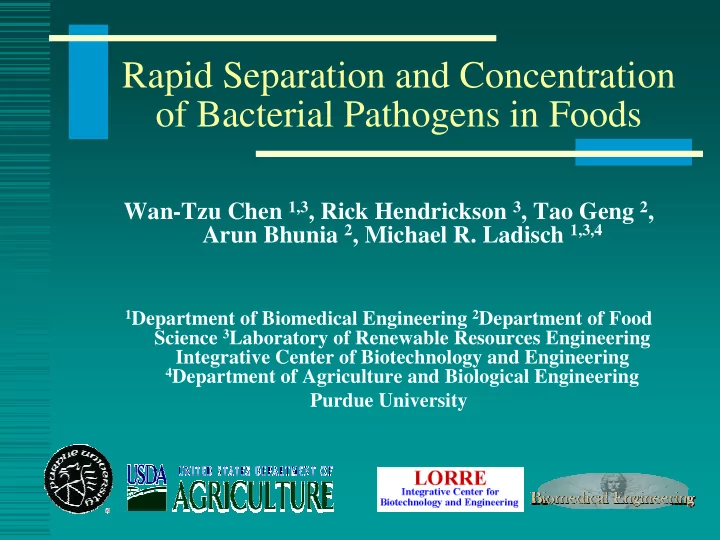

Rapid Separation and Concentration of Bacterial Pathogens in Foods Wan-Tzu Chen 1,3 , Rick Hendrickson 3 , Tao Geng 2 , Arun Bhunia 2 , Michael R. Ladisch 1,3,4 1 Department of Biomedical Engineering 2 Department of Food Science 3 Laboratory of Renewable Resources Engineering Integrative Center of Biotechnology and Engineering 4 Department of Agriculture and Biological Engineering Purdue University
Acknowledgement This research was supported through a cooperative agreement with the ARS of the United States Department of Agriculture project number 1935-42000- 035 � Dr. Richard Linton (FSEC at Purdue University) � Dr. Rashid Bashir � Debby Sherman and Chia-Ping Huang � LORRE group
Outline � Introduction � Objectives � Materials and Methods � Results � Conclusions
Introduction � Foodborne Pathogens � Cause diseases associated with food � Millions of people get ill annually � Food samples are complex with interfering substances � Conventional detection techniques are too costly and time-consuming
Introduction � Listeria monocytogenes � Gram-positive, rod-shaped bacterium � Highly acid/salt-resistant � Cause listeriosis � Average death rate of 20~30 % 1 µ m � Especially harmful for pregnant women � Occur in milk, cheese and ready-to-eat dairy food via post-processing contamination
based on a silicon-based chip A rapid detection procedure Overall Objective system
Biochip Project � Our approach: Sample Timely result preparation with Biochip from foods. within several Concentrate hours bacteria for 10000x � Conventional approach: � Up to a week for identification
Research Goals � Separate target microorganisms from interfering substances like proteins and lipid � Concentrate by 10000x in 10 min to avoid time-consuming culture step of 24 hours � Keep target microorganisms alive for identification � Recover microorganisms efficiently
Materials and Methods � Membrane filtration of spiked samples � Hotdog juice preparation � Efficiency of recovering and concentrating target microorganisms
Membrane Filtration � Widely used in separation, concentration and recovery of biomolecules � Simplify the procedures of diluting and concentrating � Surfactant/Enzyme proved to improve filtration rate Peterkin et al
Liquid Film ~700 cells/ml X 50 ml Liquid film Membrane filter Syringe holder Each membrane contains ~15 Assumption: 1mg=1 µ l µ l of liquid � By membrane filtration, 10 4 cells can be concentrated inside 15 µ l of liquid
How do we get them all off?
Surfactant Effects Tween 20 � Non-ionic surfactant � Reduce the surface tension of liquid � Prevent Listeria from sticking on the membrane
Hotdog Juice Preparation • 1 pack of hotdog immerse into 250 ml of PBS (pH 7.4) • Use stomacher bag to massage the hotdogs • Incubate for 2 hours • Filter unit with 0.2 µ m pores of cellulose nitrate (Sterilization)
Membrane Filters Nylon -(CH 2 -CH 2 -CH 2 -CH 2 - CH 2 -CONH-) n - PVDF -(CH 2 -CF 2 -) n - Mixed Cellulose nitrate and cellulose acetate Cellulose Polycarbonate -(O- -C(CH 3 ) 2 - - O-CO-) n -
Results � Preliminary tests � Bradford Protein Assay of filtrates � Listeria concentration calculated from plating-out
Plate count for 0.45 µ m retentate 25000 Theoretical number of bacteria 20000 Polycarbonate ) FU Nylon ing units (C Mixed Cellulose 15000 PVDF olony form 10000 C 5000 0 0 10 20 30 40 50 60 Filtration volumes(ml)
Membrane Filters Properties 1 µ m PVDF membrane 1 µ m Nylon membrane
Membrane Properties 1 µ m 1 µ m Polycarbonate membrane
Permeate Assay 0.300 Polycarbonate 0.4 um 0.250 Protein Conc(mg/ml) Mixed Cellulose 0.45 um 0.200 Control-blank Hotdog juice 0.150 0.100 0.050 0.000 10 ml 50 ml Filtered volumes(ml)
Tween 20 Effect PC Recovery Mixed Recovery percentage (%) percentage(%) 0.4 um Cellulose 0.45 um Without With Without With Tween Tween Tween Tween 1 ml 1 ml 5.27 65.36 3.44 70.41 5 ml 5 ml 5.27 58.44 5.05 86.28 10 ml 8.44 67.68 10 ml 4.61 38.03 25 ml 25 ml 8.99 48.35 1.74 13.94 50 ml 10.78 72.24 50 ml 4.82 58.48
Concentration Factor � Expressed by concentration ratio Listeria concentration after filtration (cells/ml) Listeria concentration before filtration (cells/ml)
How Concentrated Are They? 100.00 90.00 Polycarbonate 0.4 um 80.00 Mixed cellulose 0.45 um rs 70.00 cto Expected concentrated factors fa 60.00 n tio 50.00 tra cen 40.00 n o C 30.00 20.00 10.00 0.00 1 mL 5 mL 10 mL 25 mL 50 mL Filtered volumes (ml)
Pore Sizes Effects 100.00 90.00 80.00 Polycarbonate 0.4 um oncentration factors 70.00 Polycarbonate 0.2 um 60.00 50.00 40.00 C 30.00 20.00 10.00 0.00 1 mL 5 mL 10 mL 25 mL 50 mL Filtered volumes (ml)
Pore Sizes Effects (cont.) 70.00 60.00 Mixed cellulose 0.45 um factors 50.00 Mixed cellulose 0.22 um 40.00 tration 30.00 cen on C 20.00 10.00 0.00 1 mL 5 mL 10 mL 25 mL 50 mL Filtered volumes(ml)
Conclusions � Membrane filtration can easily concentrate Listeria monocytogenes into small volumes and separate interfering substances from microorganisms � Tween 20 treatment facilitates Listeria recovery � Recovery increases as pore sizes decrease � Time taken is only 2 hours compared to traditional culture steps
Questions?
Recommend
More recommend